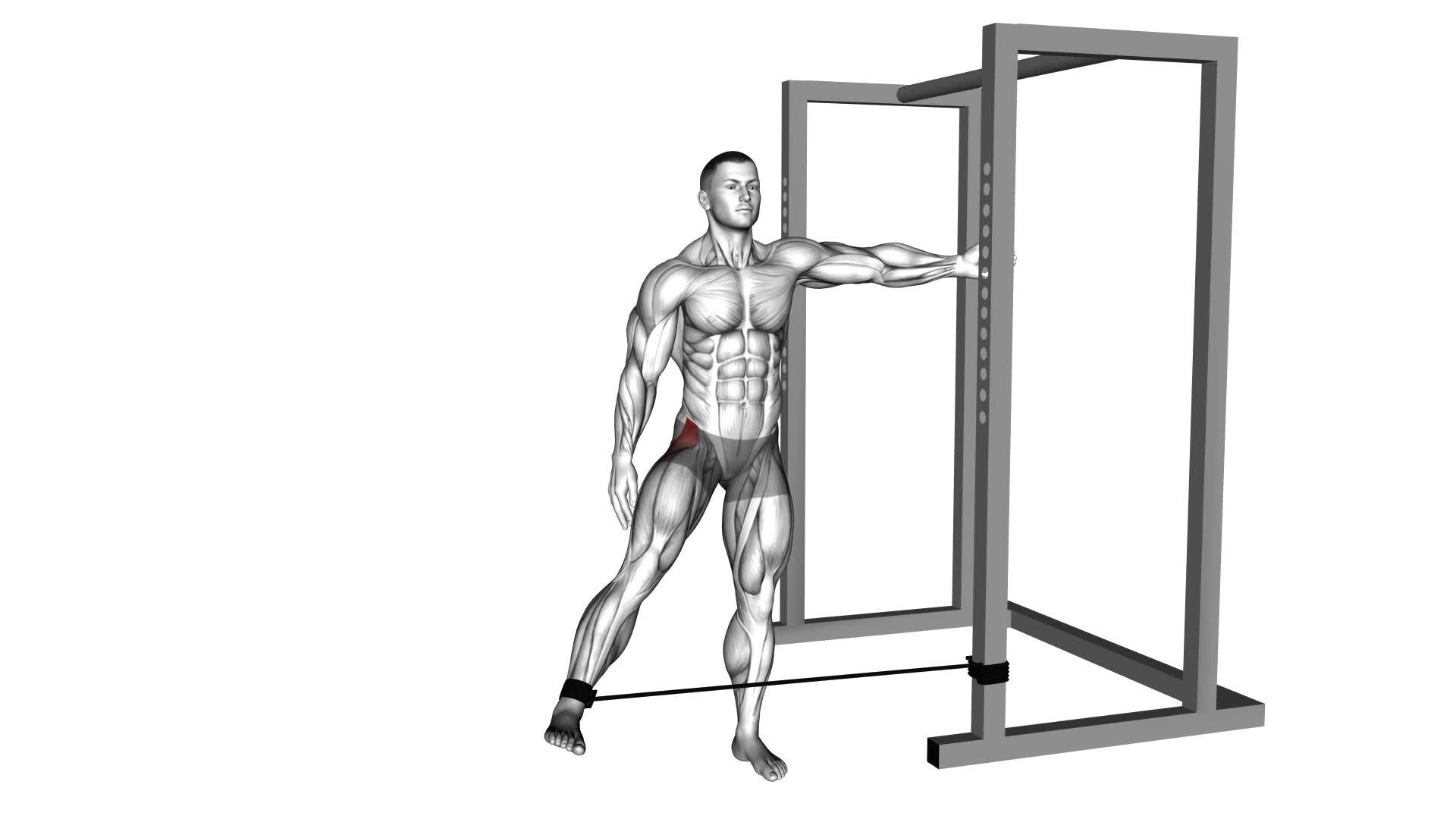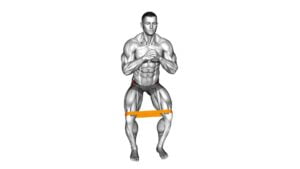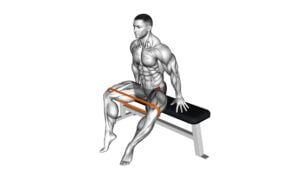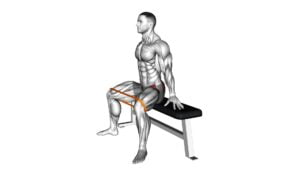Band Hip Abduction (male) – Video Exercise Guide & Tips

Looking to strengthen your hip muscles and improve your overall lower body strength? Look no further than band hip abduction exercises.
Watch This Exercise Video
In this video exercise guide, you'll find tips and proper form techniques to get the most out of this workout. Discover variations and progressions, common mistakes to avoid, and tips for incorporating band hip abduction into your routine.
Get ready to feel the burn and take your fitness to the next level. Let's get started!
Key Takeaways
- Band hip abduction targets multiple muscles in the hips, glutes, hamstrings, and core.
- It improves muscle activation, development, stability, and balance.
- Band hip abduction helps correct muscle imbalances in the hips and enhances athletic performance in running, jumping, and lateral movements.
- It can be done anywhere with a resistance band and is effective for strengthening the hip abductor muscles and improving hip stability.
Benefits of Band Hip Abduction
You should regularly incorporate band hip abduction exercises into your workout routine to reap the numerous benefits they offer. Not only do these exercises target the muscles in your hips, but they also help strengthen your glutes, hamstrings, and core. By adding resistance bands to your hip abduction exercises, you can increase the intensity and challenge of the workout. This can lead to greater muscle activation and development, as well as improved stability and balance.
One of the key benefits of band hip abduction exercises is that they can help correct muscle imbalances in the hips. Many people have weak hip abductors, which can lead to poor posture and an increased risk of injuries. By strengthening these muscles, you can improve your overall hip stability and alignment.
In addition, band hip abduction exercises can enhance athletic performance. Strong hip abductors are crucial for movements such as running, jumping, and lateral movements. By incorporating these exercises into your routine, you can improve your power, speed, and agility.
To challenge your hip abduction even further, you can try using bands with different resistance levels or incorporating variations of the exercise, such as side-lying or standing hip abductions. These variations can target different muscles and add variety to your workout routine.
In the subsequent section, we'll discuss the importance of proper form and technique when performing band hip abduction exercises.
Proper Form and Technique
To ensure optimal results and prevent injury, it's important to maintain proper form and technique when performing band hip abduction exercises. One common error that people make is allowing their knees to collapse inward during the movement. This not only reduces the effectiveness of the exercise but also puts unnecessary strain on the knees. To avoid this mistake, focus on keeping your knees in line with your toes throughout the entire range of motion.
Another common error is using too much tension in the band, which can lead to compensatory movements and improper form. It's important to choose a band with an appropriate level of resistance that allows you to maintain proper form and control.
Additionally, it's crucial to engage your core muscles and maintain a neutral spine throughout the exercise. This will help to stabilize your body and prevent any unnecessary strain on your lower back.
If you find it challenging to maintain proper form with the band hip abduction exercise, there are alternative exercises you can try. These include side-lying leg lifts, clamshells, or using a cable machine with an ankle attachment. These exercises target the same muscles and can be effective alternatives if you're having difficulty with the band hip abduction exercise.
Variations and Progressions
To progress the band hip abduction exercise and challenge your muscles further, you can incorporate variations and modifications into your routine. These variations will help target different muscle groups and add variety to your workout.
One variation you can try is the standing band hip abduction. Instead of lying on your side, stand upright and place the band around your ankles. From there, lift one leg out to the side while maintaining a slight bend in your knee.
Another variation is the seated band hip abduction. Sit on a bench or chair with the band looped around your legs just above your knees. Open your legs apart against the resistance of the band, then squeeze them back together.
You can also modify the intensity of the exercise by using bands with different levels of resistance. If you find the exercise too easy, use a band with higher resistance. On the other hand, if the exercise is too challenging, opt for a band with lower resistance.
Common Mistakes to Avoid
To ensure proper form and maximize the effectiveness of your band hip abduction exercise, it's important to be aware of common mistakes that should be avoided. Here are three common mistakes to watch out for to prevent injuries and get the most out of your workout:
- Allowing the knees to collapse inward: One of the most common mistakes during band hip abduction exercises is allowing your knees to cave inwards. This reduces the activation of the glute muscles and puts unnecessary strain on the knees. To avoid this, focus on keeping your knees in line with your toes throughout the entire movement.
- Using too much tension in the band: While it's important to use resistance to challenge your muscles, using too much tension in the band can lead to improper form and increase the risk of injury. Start with a light to moderate resistance band and gradually increase the tension as you become stronger and more comfortable with the exercise.
- Not maintaining proper alignment: Proper alignment is crucial for injury prevention and optimal muscle activation. Make sure your hips, knees, and ankles are in line with each other throughout the exercise. Avoid leaning or twisting your body to compensate for lack of strength or flexibility.
Tips for Incorporating Band Hip Abduction Into Your Workout Routine
Now that you're aware of common mistakes to avoid, how can you effectively incorporate band hip abduction into your workout routine? Band hip abduction is a great exercise for building lower body strength, particularly targeting the glutes. To add band hip abduction to your glute workout routine, follow these tips:
- Start with a warm-up: Before incorporating band hip abduction, make sure to warm up your muscles with some dynamic stretches or light cardio exercises. This will help prevent any injuries and increase the effectiveness of the exercise.
- Choose the right resistance band: Select a resistance band that provides enough resistance to challenge your muscles, but not too much that it compromises your form. Experiment with different bands to find the right level of resistance for your fitness level.
- Proper form is key: Stand with your feet shoulder-width apart and place the resistance band around your ankles. Keep your core engaged and maintain a slight bend in your knees throughout the exercise. Slowly move your leg out to the side, keeping tension on the band. Return to the starting position and repeat on the other side.
- Gradually increase intensity: As you become more comfortable with band hip abduction, you can increase the intensity by using a stronger resistance band or adding more repetitions. This will help you continue to challenge your muscles and see progress over time.
Frequently Asked Questions
How Many Repetitions and Sets Should I Perform for Band Hip Abduction Exercises?
You should perform multiple repetitions and sets for band hip abduction exercises. The exact number depends on your fitness level and goals.
Start with a moderate resistance level that challenges your muscles but allows you to maintain proper form.
As you progress, you can increase the resistance or try different variations of the exercise to keep challenging your muscles and progressing towards your goals.
Remember to listen to your body and adjust the intensity as needed.
Can Band Hip Abduction Exercises Help With Improving Balance and Stability?
Band hip abduction exercises are a great way to improve your balance and stability. By using a resistance band, you can target the muscles in your hips and glutes, which play a crucial role in maintaining balance.
These exercises help strengthen these muscles, making them more stable and improving your overall balance.
Incorporating band hip abduction exercises into your routine can be a valuable addition to your fitness regimen, enhancing both your balance and stability.
Is It Normal to Feel Some Discomfort or Fatigue in the Hip Muscles During Band Hip Abduction Exercises?
Feeling some discomfort or fatigue in your hip muscles during band hip abduction exercises is normal. This is because these exercises target and strengthen the muscles in your hips, specifically the muscles responsible for hip abduction.
As you perform the exercise, these muscles are being challenged and worked, which can result in temporary discomfort or fatigue. It's important to listen to your body and take breaks as needed, but this discomfort is generally a sign that your muscles are being engaged and strengthened.
Can Band Hip Abduction Exercises Be Beneficial for Individuals With Knee or Hip Joint Issues?
Band hip abduction exercises can be beneficial for individuals with knee or hip joint issues. They provide an alternative to traditional exercises that put more stress on these joints. By using resistance bands, you can strengthen the muscles around the hips without putting excessive strain on the knees or hips.
This can help improve stability and support for the joints, reducing the risk of further injury or discomfort. Incorporating band resistance training into your routine can have numerous benefits for joint health.
Are There Any Specific Warm-Up Exercises or Stretches Recommended Before Performing Band Hip Abduction Exercises?
Before performing band hip abduction exercises, it's important to warm up your muscles and prepare your body. Incorporating specific warm-up exercises and stretching techniques can help prevent injuries and improve the effectiveness of the workout.
By engaging in dynamic movements like leg swings or marching in place, you can increase blood flow and loosen up your hips.
Additionally, performing hip stretches such as the standing hip flexor stretch or the seated butterfly stretch can help improve flexibility and range of motion.
Conclusion
Incorporating band hip abduction exercises into your workout routine can provide numerous benefits, such as strengthening the hip muscles and improving overall lower body stability.
By maintaining proper form and technique, avoiding common mistakes, and gradually progressing in difficulty, you can maximize the effectiveness of this exercise.
Remember to consult with a fitness professional if you have any concerns or questions.
Start incorporating band hip abduction into your routine and enjoy the results!

Author
Years ago, the spark of my life’s passion ignited in my mind the moment I stepped into the local gym for the first time. The inaugural bead of perspiration, the initial endeavor, the very first surge of endorphins, and a sense of pride that washed over me post-workout marked the beginning of my deep-seated interest in strength sports, fitness, and sports nutrition. This very curiosity blossomed rapidly into a profound fascination, propelling me to earn a Master’s degree in Physical Education from the Academy of Physical Education in Krakow, followed by a Sports Manager diploma from the Jagiellonian University. My journey of growth led me to gain more specialized qualifications, such as being a certified personal trainer with a focus on sports dietetics, a lifeguard, and an instructor for wellness and corrective gymnastics. Theoretical knowledge paired seamlessly with practical experience, reinforcing my belief that the transformation of individuals under my guidance was also a reflection of my personal growth. This belief holds true even today. Each day, I strive to push the boundaries and explore new realms. These realms gently elevate me to greater heights. The unique combination of passion for my field and the continuous quest for growth fuels my drive to break new ground.







